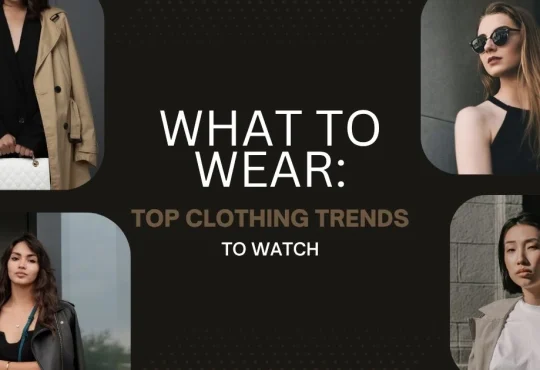Fashion has always been shaped by transformation, and the latest evolution unfolds at the intersection of technology and style. Known as “phygital” fashion, this fusion of physical and digital worlds is reshaping design, shopping, and the overall experience of clothing. No longer limited to runways or retail spaces, fashion now expands into virtual landscapes, augmented reality mirrors, and blockchain-backed collectibles. This hybrid model redefines not only garments themselves but also how creativity, commerce, and self-expression intersect.
The rise of phygital fashion is fueled by innovations such as virtual runway shows, 3D clothing previews, and avatar-only outfits on platforms like Roblox, Fortnite, and Decentraland. Major luxury brands, from Gucci to Balenciaga and Louis Vuitton, are experimenting with digital drops and exclusive NFTs, while independent designers turn to AR try-ons as a cost-effective way to engage global audiences. In many cases, digital purchases are accompanied by their physical counterparts—like a hoodie that exists both in the metaverse and in real life. This blend caters to two growing desires: unique self-expression in virtual worlds and lasting quality in the physical realm.
What Is Phygital Fashion?
Phygital fashion blends physical clothing with digital experiences, forming a hybrid realm where garments simultaneously inhabit the real and virtual worlds. At its core, it bridges the gap between traditional fashion and technology-driven innovation, responding to the way people now live, shop, and express themselves across multiple worlds. In practice, this could mean purchasing a jacket you can wear in real life that also comes with a digital twin for your gaming avatar, or attending a fashion show where the front row is filled not with editors, but with avatars in the metaverse.
Unlike traditional fashion, which depends solely on physical fabrics and craftsmanship, phygital fashion introduces a dynamic layer of interactivity that bridges the physical and digital. It allows designers to push creativity beyond the limits of fabric, while consumers gain the freedom to experiment with identity in ways that transcend physical constraints. Want a glowing, animated dress that shifts colors as you move? In digital form, it’s possible. Want your favorite sneakers to follow you both on the streets and on your favorite online platform? That’s the promise of phygital.
This model also reshapes how people engage with style. Fashion is no longer only about what hangs in your closet; it’s about the outfits you wear in augmented reality selfies, the NFT sneakers you collect as digital status symbols, and the hybrid drops that merge craftsmanship with code. In essence, phygital fashion turns clothing into a multi-dimensional experience, extending beyond the runway or retail store to become part of both your physical presence and your digital identity.
Why Phygital Fashion Is Trending
Several factors have fueled the rise of phygital fashion. The boom in gaming and virtual worlds has normalized the idea of digital self-expression, while social media continues to drive demand for unique, shareable looks. At the same time, the pandemic accelerated digital adoption, making consumers more comfortable with AR try-ons, virtual showrooms, and digital-only fashion collections. Add in the popularity of NFTs and blockchain technology, and fashion suddenly has a new way to merge exclusivity with innovation.
Real-World Examples
Luxury and streetwear brands alike are diving into phygital releases, blending physical products with digital counterparts that extend their presence into gaming platforms, AR spaces, and the metaverse.
- Gucci sold digital sneakers called Gucci Virtual 25, designed only to be worn in AR and gaming platforms.
- Balenciaga partnered with Fortnite to create digital skins alongside physical merchandise.
- Nike launched. Swoosh is a digital platform where users can collect, trade, and co-create virtual apparel.
- Startups like DressX and The Fabricant specialize in digital-only fashion pieces, catering to influencers and gamers looking to stand out online.
These collaborations show how the line between fashion, gaming, and tech is blurring, and why consumers are eager to participate in both worlds.
Sustainability Benefits
Beyond being a futuristic innovation, phygital fashion offers real potential for sustainability in an industry often criticized for its environmental impact. By using 3D modeling and digital prototyping, designers can refine their creations virtually before producing physical samples, significantly cutting down on fabric waste. Virtual try-on tools also make online shopping smarter and more accurate, helping customers choose the right fit the first time and reducing the environmental toll of returns—a persistent issue in e-commerce.
Digital-first drops take this a step further by allowing brands to test consumer interest before committing to full-scale production. Instead of overproducing and risking unsold stock, they can manufacture only what’s truly in demand, leading to less waste and a smaller carbon footprint. In this way, phygital fashion is more than a technological trend—it’s a forward-thinking, eco-conscious approach that aligns creativity with responsibility.
The Future of Phygital Fashion
The future of phygital fashion lies in seamless integration between the real and virtual worlds. As technologies like AR glasses, VR platforms, and Web3 continue to advance, digital overlays will become part of everyday life. Picture yourself at a concert where your jacket emits glowing patterns visible only to those wearing AR devices, or shopping for a designer piece that instantly comes with a matching version for your gaming avatar. Clothing will no longer be limited to fabric and stitching—it will evolve into a dynamic, programmable layer of personal expression.
What makes this future compelling is not the replacement of physical fashion, but its transformation. Phygital fashion will expand identity and community across multiple realities, allowing individuals to style themselves both offline and online without distinction. Exclusive NFT drops, AI-powered personalization, and immersive digital wardrobes will add new dimensions to how people connect with brands and each other. In this way, fashion’s future isn’t about choosing between digital or physical—it’s about living in a world where both coexist, enhancing creativity and sustainability.
[wp_GAM_ADS_InPos2_shortcode]
Understanding Phygital Fashion
Fashion has always reflected culture, technology, and identity. Today, a new wave of innovation is reshaping the industry: phygital fashion. The concept merges the physical and digital, referring to clothing and accessories designed to exist simultaneously in both realities. This could mean buying a luxury handbag that comes with an NFT twin, trying on outfits in augmented reality before purchasing, or dressing your avatar in the same sneakers you wear in real life.
Phygital fashion is more than a buzzword—it’s a shift in how consumers purchase, experience, and express fashion. It merges tangible craftsmanship with immersive technology, allowing people to live in style across the physical world and the digital spaces where they spend more time.
Why Phygital Fashion Is on the Rise
Several cultural and technological forces are driving this movement:
- Gaming and virtual worlds – Platforms like Roblox, Fortnite, and Decentraland have normalized digital identities and skins. Clothing is no longer limited to reality.
- Social media influence – With billions posting daily, fashion isn’t just about what you wear in real life—it’s about your online persona. Digital looks can be shared instantly without shipping delays or laundry days.
- Pandemic-driven digital adoption – Lockdowns pushed brands to explore virtual runways, AR fitting rooms, and online exclusives. Consumers became comfortable buying fashion without ever touching it first.
- Blockchain and NFTs – Digital tokens introduced rarity and ownership into virtual fashion, making digital garments feel as exclusive as couture pieces.
Brands Leading the Phygital Revolution
Both luxury houses and emerging startups are embracing phygital strategies:
- Gucci introduced the Gucci Virtual 25 sneakers, priced at $12, designed exclusively for wear in AR settings and gaming platforms. The label also introduced an immersive Gucci Garden experience within Roblox, blending interactive storytelling with digital fashion.
- Balenciaga: Partnered with Fortnite to sell both digital skins and matching physical apparel, proving fashion can thrive inside gaming ecosystems.
- Nike: Launched. Swoosh, a Web3 platform for digital apparel and co-creation, acquired RTFKT, a startup known for its digital sneakers and collectibles.
- Louis Vuitton: Released limited-edition NFTs tied to its 200th anniversary, merging brand heritage with future-focused storytelling.
- DressX: A digital-only fashion marketplace, allowing influencers to “wear” futuristic clothing in photos and videos without ever shipping a garment.
These examples highlight how fashion houses are not only keeping pace with digital culture but actively shaping it.
The Sustainability Argument
Phygital fashion is also finding relevance in sustainability conversations:
- Reduced fabric waste – Designers use 3D software to prototype garments, cutting down the need for physical samples.
- Lower return rates – AR try-ons help customers choose better fits, reducing the waste associated with returns.
- Smarter production – Brands can test digital-only collections before deciding what to manufacture, preventing overproduction.
- Circular possibilities – Blockchain-based tracking offers transparency in supply chains and resale markets, making sustainable fashion more traceable.
For eco-conscious consumers, phygital fashion isn’t just fun—it’s a smarter, greener way forward.
How Consumers Benefit
The phygital model redefines fashion as an experience:
- You can wear a jacket IRL and instantly dress your avatar in the same piece.
- AR filters provide virtual try-on experiences, reducing the uncertainty often associated with online shopping.
- Digital exclusives allow you to own statement pieces that don’t clutter closets.
- Collectors can invest in limited digital drops, which may gain value over time.
Fashion, in this sense, is no longer about ownership alone—it’s about participation and expression across platforms.
The Future of Phygital Fashion
The next stage of phygital fashion will move beyond novelty into everyday life:
- AR glasses could project digital clothing overlays in real time, letting people “see” different outfits on you.
- Virtual concerts and events will integrate fashion, making what you wear online as important as your real-world wardrobe.
- AI-driven personalization will let brands design unique phygital garments tailored to each customer’s digital and physical lifestyle.
- Cross-platform wardrobes may emerge, where one purchase instantly syncs across gaming, social media, and physical life.
In short, phygital fashion is heading toward mainstream adoption, where digital and physical aren’t separate—they’re intertwined.
Connecting Real and Virtual Identities
Phygital fashion represents more than a trend; it’s a cultural transformation. Merging craftsmanship with technology it allows self-expression to transcend physical boundaries and embrace digital identities. For brands, it opens up new creative playgrounds and sustainable practices. For consumers, it provides fresh ways to connect, experiment, and stand out.





